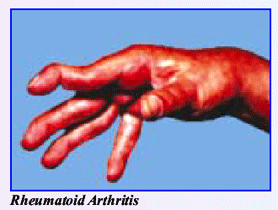 Home >> Newsletter>> Disease of the month
Home >> Newsletter>> Disease of the month
ARTHRITIS: AYURVEDA GIVES A HOPE
Introduction:
Ayurveda is an ancient science of life, which has the finest healing properties. The practice of Ayurvedic treatments finds many references in Rig Veda, Atharva Veda, Bhagwata Geet a, Upanisads and Ramaya na. The major part of Ayurveda has been discussed in details in Atharva Veda. It was only around 3000 years ago that Caraka and Susruta who happened to be the most famous Ayurvedic doctors of ancient times presented the concepts and treatments of Ayurveda in a written form. The whole concept of understanding disease, the causes, the pathogenesis (how a disease evolves), the diagnostic methods and the treatments give an example of the understanding of the human system amongst ancient Indian sages and scholars.Manuscripts written on the leaves and barks of trees have now been translated and printed in the book form these days. Almost all diseases have been discussed, the health promotion methods have been discussed and the methods of a healthy living also form a part of the Ayurvedic texts. It is said history takes a full circle. In the similar manner Ayurveda is becoming very popular as it used to be in ancient times. The only difference is that in the present times the health care is primarily in the hands of technologically advanced Allopathic system of Medicine, which is good for operations and surgical interventions. Antibiotics and strong painkillers have made allopathic system the first preference. Ayurveda has been proven to be of excellent value for chronic diseases where the allopathic system has a limited role. This is just an example of how limitations in one system make you to explore the other systems of medicine. One such disease where Ayurveda is said to score better is Arthritis.
Arthritis has been dealt in the Ayurvedic books in great details. There are several types of Arthritis like Sandhivata,
Amvata, V atarakta that have similarity to the nomenclature of Osteoarthritis, Rheumatoid Arthritis and Gout. The disorders of spine like Cervical and Lumbar Spondylitis and Psoriatic arthritis too are known well in Ayurvedic literature. Even the treatments prescribed in Ayurveda are very well tried and tested for their efficacy. The modern investigations like X-Ray, MRI, CT Scan are also being used by Ayurvedic doctors to understand the disease process.
Types of Arthritis
 Osteoarthritis (Sandhigatav ata) is said to be primarily due to a disorder in V ata do sa and occurs primarily in the age group of 40 years and above, when V ata becomes more aggravated in the system. Women are likely to be affected more than men because of the Calcium depletion and accompanying Osteoporosis due to the hormonal changes that occur during the menopause. Commiphora mukul, Boswellia serrata, Pluchea lanceolata, Zingiber officinalis are the commonly used single drugs but a combination of many similarly acting medicinal herbs is very often preferred by the doctors. Along with medicines, Pancakarma procedures like Abhyanga, Swedana and Basti form the mainstay of treatment. Gold and coral remedies are prescribedin complicated cases of Osteoarthrosis for an early recovery.
Amvata or what is popularly known as Rheumatoid Arthritis derives its names from two words
Osteoarthritis (Sandhigatav ata) is said to be primarily due to a disorder in V ata do sa and occurs primarily in the age group of 40 years and above, when V ata becomes more aggravated in the system. Women are likely to be affected more than men because of the Calcium depletion and accompanying Osteoporosis due to the hormonal changes that occur during the menopause. Commiphora mukul, Boswellia serrata, Pluchea lanceolata, Zingiber officinalis are the commonly used single drugs but a combination of many similarly acting medicinal herbs is very often preferred by the doctors. Along with medicines, Pancakarma procedures like Abhyanga, Swedana and Basti form the mainstay of treatment. Gold and coral remedies are prescribedin complicated cases of Osteoarthrosis for an early recovery.
Amvata or what is popularly known as Rheumatoid Arthritis derives its names from two words  i.e. Ama & V ata. Ama means undigested and V ata is the component, which is responsible for the proper functions of movement. Vata disorders give rise to severe pain and movement disorders. The word ‘s ama’ indicates that the starting point of Rheumatoid is the gastrointestinal system and the impaired digestion. The treatments in Ayurveda are also aimed at improving the digestion, controlling V ata by the use of different types of Guggulu preparations specially meant for Rheumatoid arthritis. The use of Swar 6a Bhasma and its compounds restore the functions of joint mobility and pain to a great extent. No amount of external applications help in this disease. Dry heat by the way of fomentation with thermopads or hot water bags is preferred. Stiffness of the body and joints is the main feature of this illness. Feeling of having low-grade fever also is an important symptom of this illness. Rheumatoid factor may or may not show to be positive. ESR goes up when the disease is active. Primarily the clinical condition is the direct reflection of this problem. La kghana is the first thing an
i.e. Ama & V ata. Ama means undigested and V ata is the component, which is responsible for the proper functions of movement. Vata disorders give rise to severe pain and movement disorders. The word ‘s ama’ indicates that the starting point of Rheumatoid is the gastrointestinal system and the impaired digestion. The treatments in Ayurveda are also aimed at improving the digestion, controlling V ata by the use of different types of Guggulu preparations specially meant for Rheumatoid arthritis. The use of Swar 6a Bhasma and its compounds restore the functions of joint mobility and pain to a great extent. No amount of external applications help in this disease. Dry heat by the way of fomentation with thermopads or hot water bags is preferred. Stiffness of the body and joints is the main feature of this illness. Feeling of having low-grade fever also is an important symptom of this illness. Rheumatoid factor may or may not show to be positive. ESR goes up when the disease is active. Primarily the clinical condition is the direct reflection of this problem. La kghana is the first thing an
Ayurvedic doctor would prescribe. La kghana means keeping fast and eating less to improve digestion. This is good for patients of Rheumatoid Arthritis. Local Application of Da sanga Lepa, Rason and Sunthi Lepa, Nirgu 6d i and Era 6da patra do help in reducing the pain and inflammation of the affected joint. Due to the side effects of steroids and painkillers, it is always advised to go for Ayurvedic treatments that are effective and safer for a long-term treatment.
For More Details :--
Read AMAM Ayurveda Heritage Vol-1, Issue 4, October-December 2005





 Osteoarthritis (Sandhigatav ata) is said to be primarily due to a disorder in V ata do sa and occurs primarily in the age group of 40 years and above, when V ata becomes more aggravated in the system. Women are likely to be affected more than men because of the Calcium depletion and accompanying Osteoporosis due to the hormonal changes that occur during the menopause. Commiphora mukul, Boswellia serrata, Pluchea lanceolata, Zingiber officinalis are the commonly used single drugs but a combination of many similarly acting medicinal herbs is very often preferred by the doctors. Along with medicines, Pancakarma procedures like Abhyanga, Swedana and Basti form the mainstay of treatment. Gold and coral remedies are prescribedin complicated cases of Osteoarthrosis for an early recovery.
Amvata or what is popularly known as Rheumatoid Arthritis derives its names from two words
Osteoarthritis (Sandhigatav ata) is said to be primarily due to a disorder in V ata do sa and occurs primarily in the age group of 40 years and above, when V ata becomes more aggravated in the system. Women are likely to be affected more than men because of the Calcium depletion and accompanying Osteoporosis due to the hormonal changes that occur during the menopause. Commiphora mukul, Boswellia serrata, Pluchea lanceolata, Zingiber officinalis are the commonly used single drugs but a combination of many similarly acting medicinal herbs is very often preferred by the doctors. Along with medicines, Pancakarma procedures like Abhyanga, Swedana and Basti form the mainstay of treatment. Gold and coral remedies are prescribedin complicated cases of Osteoarthrosis for an early recovery.
Amvata or what is popularly known as Rheumatoid Arthritis derives its names from two words  i.e. Ama & V ata. Ama means undigested and V ata is the component, which is responsible for the proper functions of movement. Vata disorders give rise to severe pain and movement disorders. The word ‘s ama’ indicates that the starting point of Rheumatoid is the gastrointestinal system and the impaired digestion. The treatments in Ayurveda are also aimed at improving the digestion, controlling V ata by the use of different types of Guggulu preparations specially meant for Rheumatoid arthritis. The use of Swar 6a Bhasma and its compounds restore the functions of joint mobility and pain to a great extent. No amount of external applications help in this disease. Dry heat by the way of fomentation with thermopads or hot water bags is preferred. Stiffness of the body and joints is the main feature of this illness. Feeling of having low-grade fever also is an important symptom of this illness. Rheumatoid factor may or may not show to be positive. ESR goes up when the disease is active. Primarily the clinical condition is the direct reflection of this problem. La kghana is the first thing an
i.e. Ama & V ata. Ama means undigested and V ata is the component, which is responsible for the proper functions of movement. Vata disorders give rise to severe pain and movement disorders. The word ‘s ama’ indicates that the starting point of Rheumatoid is the gastrointestinal system and the impaired digestion. The treatments in Ayurveda are also aimed at improving the digestion, controlling V ata by the use of different types of Guggulu preparations specially meant for Rheumatoid arthritis. The use of Swar 6a Bhasma and its compounds restore the functions of joint mobility and pain to a great extent. No amount of external applications help in this disease. Dry heat by the way of fomentation with thermopads or hot water bags is preferred. Stiffness of the body and joints is the main feature of this illness. Feeling of having low-grade fever also is an important symptom of this illness. Rheumatoid factor may or may not show to be positive. ESR goes up when the disease is active. Primarily the clinical condition is the direct reflection of this problem. La kghana is the first thing an